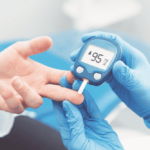A type 2 diabetes diagnosis is life changing. It cannot only be a wake-up call for your poor lifestyle choices over the years, but you will need to embrace healthier behaviors to protect your health and manage the chronic condition.
People who live with type 2 diabetes may face challenges qualifying for health and life insurance. Type 2 diabetes life insurance rates tend to be higher compared to non diabetics. In the event your control of diabetes is poor, you may only qualify for no exam life insurance for diabetics.
While it is natural to feel upset or overwhelmed after receiving the news, you will be pleased to learn that it is possible to live a healthy, happy life with diabetes. Plus, you may be able to reverse the condition. Here are four steps to take after a type 2 diabetes diagnosis.
Step 1: Understand the Condition
It is important to learn as much as possible about type 2 diabetes following a diagnosis. Your doctor can provide information regarding the condition, but some research could improve your understanding of making smarter health decisions. For example, learn how the condition develops, the key steps to take to reverse or manage the condition, avoid a hypoglycemic event, and identify hypo signs.
Step 2: Change Your Diet
Following a diagnosis, a doctor may advise you to change your diet to manage your blood sugar (glucose) levels. According to the CDC, 9 out of 10 people living with type 2 diabetes are medically classified as overweight. Losing between 5 to 10lbs of your body weight could reduce your blood sugar levels, which can decrease your need for medication.
While there isn’t a one-size-fits-all diet for diabetes, there are healthy changes you can make to lose weight, such as:
- Consuming more fiber-rich foods, such as non-starchy vegetables, fruits, and whole grains
- Reducing your portion sizes
- Eating a moderate amount of dairy, fish, and lean meat
- Decrease fat, sugar, and salt intake
- Cooking with healthier oils, such as olive oil or canola oil
Step 3: Find the Right Glucose Monitoring System
It is crucial to measure your blood sugar levels throughout the day to avoid a hypoglycaemic event. A smart glucose monitoring system can make managing diabetes a breeze. The pocket-sized device provides highly accurate measurements within six seconds and requires only a small drop of blood. Also, the handy app allows you to monitor your levels, count your carbs, monitor your medication, and exercise, and send an emergency hypo alert to your friends or family.
Step 4: Start Exercising
In addition to developing a healthier diet plan and finding the right glucose monitoring system, you must incorporate more physical activity into your daily routine. Exercise will help you lose weight and manage your blood sugar levels. Plus, it can prevent type 2 diabetes complications, such as cardiovascular disease.
The ADA recommends people living with type 2 diabetes experience a minimum of 150 minutes of moderate to vigorous aerobic exercise each week, which they can spread out across the week. Also, you must limit sedentary behaviors each day and ensure you don’t experience more than two days of zero physical activity.
If you notice any changes to your blood sugar levels or develop new symptoms, book an appointment with your doctor as soon as possible. They might need to review and adjust your treatment plan to help you manage the condition.
Daniel Casciato is a highly accomplished healthcare writer, publisher, and product reviewer with 20 years of experience in the industry. He is the proud owner and publisher of Healthcare Business Today, a leading source for the healthcare industry's latest news, trends, and analysis.
Daniel founded Healthcare Business Today in 2015 to provide healthcare professionals and enthusiasts with timely, well-researched content on the latest healthcare news, trends, and technologies. Since then, he has been at the forefront of healthcare writing, specializing in product reviews and featured stories.
His expertise in the healthcare industry is evident from the numerous publications he has written for, including Cleveland Clinic's Health Essentials, Health Union, EMS World, Pittsburgh Post-Gazette, Providence Journal, and The Tribune-Review. He has also written content for top-notch clients, such as The American Heart Association, Choice Hotels, Crohn's & Colitis Foundation of America, Culver's Restaurants, Google Earth, and Southwest Airlines.
Daniel's work has been instrumental in educating the public and healthcare professionals about the latest industry innovations. In addition, his dedication and passion for healthcare writing have earned him a reputation as a trusted and reliable source of information in the industry.
Through Healthcare Business Today, Daniel is committed to sharing his knowledge and expertise with the world, contributing to the growth and development of the healthcare industry.






